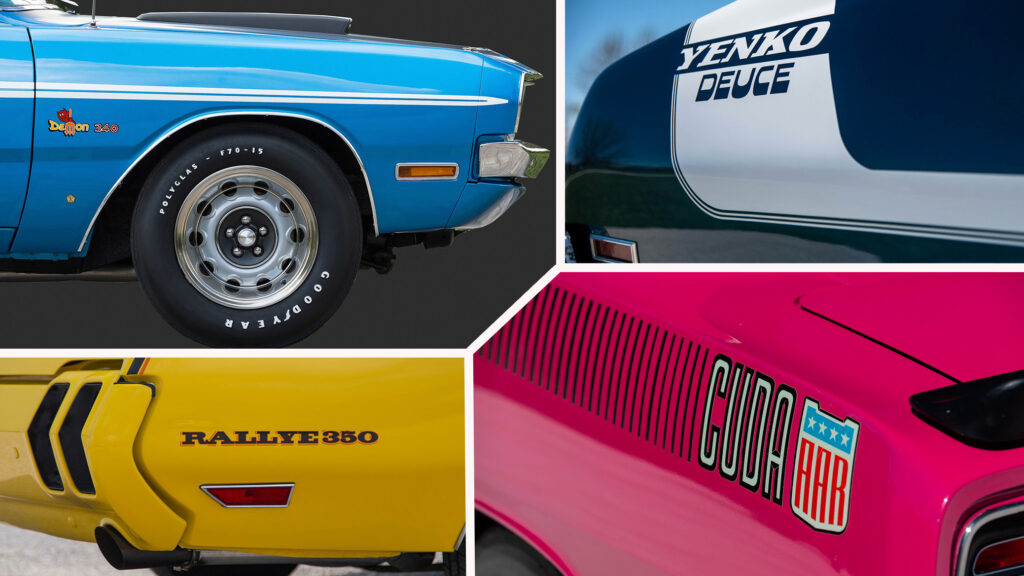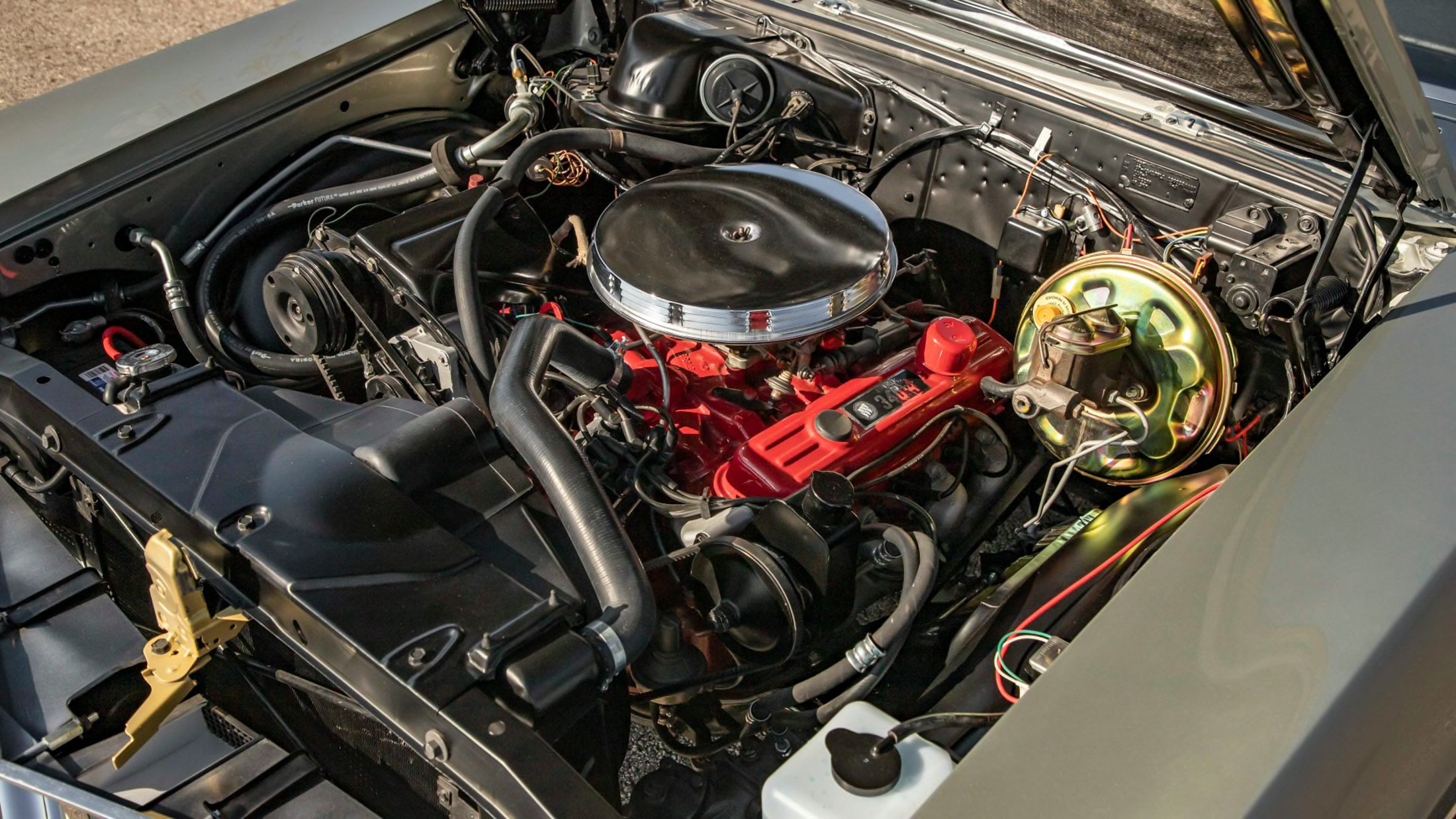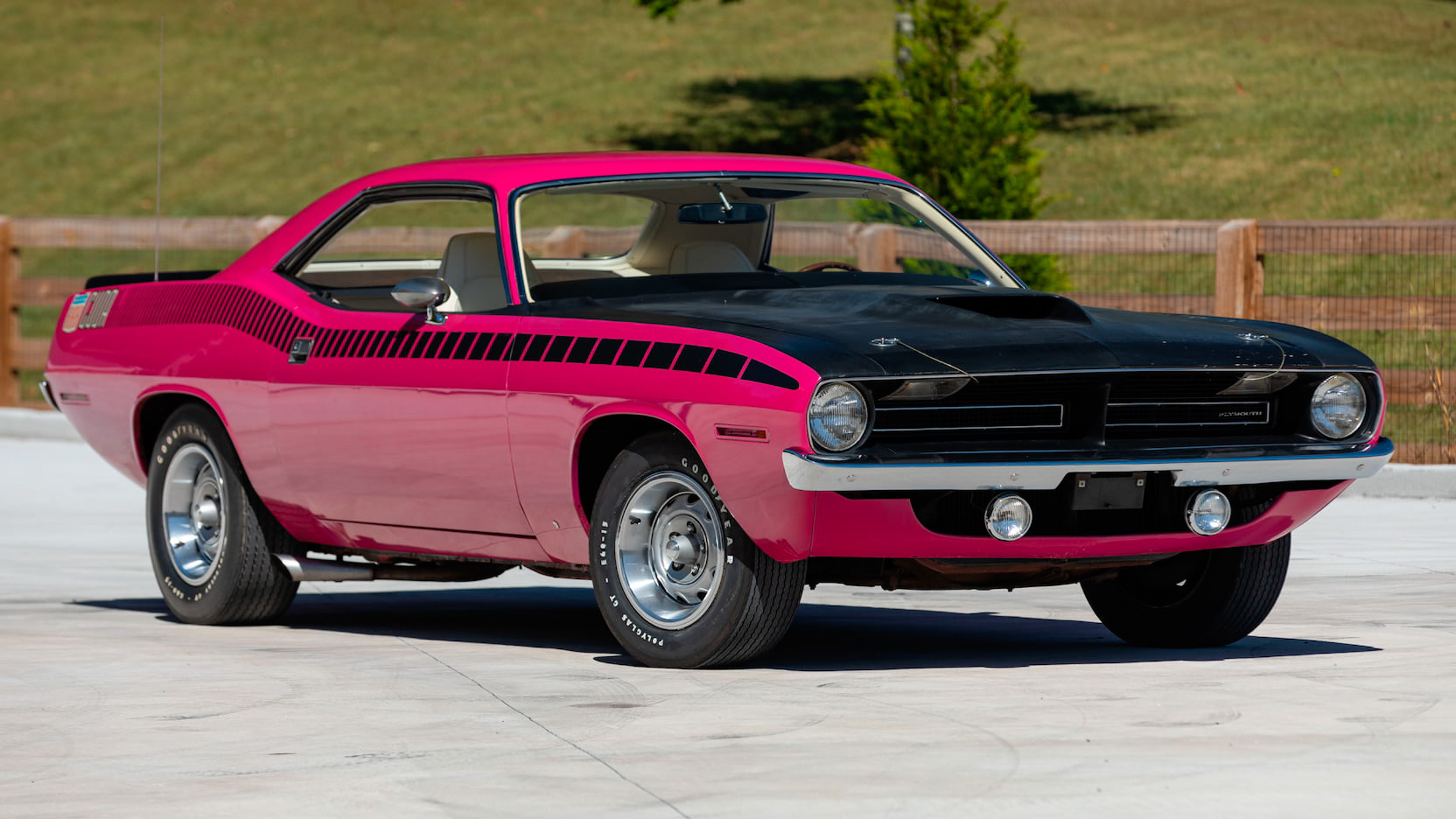When we’re talking about performance machinery it’s only natural that our focus shifts to the most extreme, most powerful and fastest models, whether they be hot hatches, sports cars, supercars or metal from the mid 1960s to the dawn of the 1970s that make up the golden era of muscle.
But in giving so much attention to the 7-liter muscle monsters we’re in danger of forgetting the highly-tuned, small-cube muscle cars that automakers built either to go racing or to attract buyers who couldn’t fund the purchase price, scary insurance premiums and 11 mpg thirst of the big block machines. Those buyers still wanted a car that looked and moved fast, and maybe some just liked the idea of a lighter car that handled better and revved harder.
Think of cars like the Dodge Dart GTS 340 as the Golf GTI to the Dart GTS 383’s Golf R. And hardcore homologation specials like the original Chevy Camaro Z28 and Ford Mustang Boss 302 were more like a Golf GTI Clubsport S. Most of these small-capacity hot rods had around 300 gross hp (304 PS), some made far more in truth, and some could even dip into the low 14s in the quarter miles, so they weren’t slow.
Related: What’s The Worst Muscle Car Of All Time?
Broadly speaking, you can compile this kind of list by choosing only muscle cars with small-block, rather than big-block, V8s. But that doesn’t work for the likes of AMC and Pontiac whose big and small engines were all derived from the same family. So instead we’re going to do it by capping capacity at 360 cu-in (5.9 liters) and look at the cars built between 1964 and 1971 with the help of the incredible muscle car picture archive that is auction house Mecum‘s website.
1971 AMC Hornet SC/360
AMC served up engines as big as 401 cu-in (6.6 L) in the Javelin pony car in 1971, but abandoned plans to do the same with the Hornet compact, meaning its hottest motor was a 360 cu-in mill in the SC/360. That pumped out 285 hp (289 hp) with the help of the four-barrel carb and Ram Air induction that came with the optional “Go” package, which wasn’t bad considering the low compression ratios Detroit was running that year. And neither was Motor Trend’s 6.7-second zero to 60 mph (96 km/h) time or the sub-$2,800 ($22k in modern money) price.
1967 Buick GS 340
Buick renamed its mid-size Gran Sport the “GS 400” for 1967 in recognition of the capacity of its new V8. But while that 6.6-liter model was aimed at the Pontiac GTO, Buick recognized a chance to widen its audience with a less powerful, more affordable version, the GS 340. The 5.6-liter motor’s 260 hp (264 PS) output put the 340 at a massive 80 hp (81 PS) disadvantage to its big brother, but the car still looked the part, and by 1970’s GS 350, the understudy was making a respectable 315 horses (319 PS).
1965 Chevrolet Chevelle SS 327/350
Chevy was slower than its GM stablemates to bust the General’s ban on big-cube engines in intermediate cars. But that didn’t mean it was bereft of performance options. You could order Chevy’s punchy 300 hp (304 PS), 327 cu-in (5.4-liter) small-block in a 1964 Chevelle, and the following year both the Chevelle and its Nova little brother were available with a 350 hp L79 version of that motor, which made the lightweight Nova good for 60 mph in 7.2 seconds and turned the Malibu seen above into a grandma car with real go.
1967 Chevrolet Camaro Z28
Never judge a car by its pony count. The high-winding 302 cu-in (4.9-liter) V8 in the Camaro Z28 was the result of mashing up Chevy’s 283 and 327 V8s to come up with something that fitted under the new Trans Am championship’s 305-cube capacity limit. It revved to almost 7k and was comically underrated at just 290 hp (294 PS). Forget the Camaro’s available 396 (6.5-liter) V8; even the mid-range SS 350 outpunched it on paper.
But definitely not in practice. Though designed for a snaking roads, not strips, the Z could still reach 60 mph in 6.7 seconds and eat a quarter in 14.9 seconds, beating the 295 hp (299 PS) SS 350 by more than a second in each case.
1970 Yenko Deuce
The Z28 and Corvette both got a got new small-block for 1970: the LT1. Measuring 350 cu-in (5.7 liters) and equipped with solid valve lifters and a chunky 11.0:1 compression ratio it was rated at 360 hp (365 PS) in the Vette and 350 hp (355 PS) in the Z. But the one car it seemed a natural fit for, never got it. The Nova was available with milder 350s and also the big 396 (which actually displaced 402 cubes for ’70), but not the LT1.
Enter Don Yenko, a horsepower junkie with a hotline to GM who persuaded the factory to slot the 360-hp small-block in Chevy’s smallest car for his customers. The Nova “Deuce” looked like a great package – and a hell of a lot less likely to land you in hospital than the 427 (7-liter) transplant Yenko also offered.
1968 Dodge Dart GTS 340
The ’68 Dart GTS 340’s claimed 275 hp (278 PS) output might sound underwhelming but Chrysler was undoubtedly fibbing about the 5.6-liter mill’s true potential so as not to make upgrading to the 330 hp (335 PS) 383 (6.3 liter) look pointless to buyers.
Car & Driver took a 340 to 60 mph in 6 seconds flat and covered the quarter mile in 14.4 seconds at 99 mph (160 km/h) – numbers that in no way match the claimed meager power output. If there was a downside it’s that a starting price of $3,189 ($28,187 at modern prices) wasn’t that low, but Dodge came up with an answer for 1969 by making the 340 an option on the sporty but spartan Dart Swinger.
1965 Shelby Mustang GT350
Big-block power didn’t materialize between the Mustang’s front wheels until 1967, but the top-spec K-code 289 (4.7-liter) Hi-Po V8’s 271 hp (275 PS) wasn’t too shabby, recording mid-sevens to 60 mph. Plenty of room for improvement, though, or so Carroll Shelby thought.
Shel’s 1965 GT350 sliced a second off that sprint time by adding a new carb, intake and exhaust headers that boosted power to 306 horses (310 PS), or even more with the optional Paxton supercharger. Plus it came with suspension and drivetrain mods that made it a serious driver’s car. Unfortunately the price was more serious too: the GT350 cost over 35 per cent more than a K-code Mustang.
1969 Ford Mustang Boss 302
For 1969 Ford came up with two wildly different performance Mustangs to homologate its racing activities. Strangely, the Boss 429 existed only to legalize the new 7.0-liter hemi-headed engine’s use in Torinos in NASCAR, but the Boss 302 was a more straightforward proposition: it wanted to kick Chevy’s Camaro Z28 into the sand in circuit racing.
Related: If You Could Own One American Muscle Car, What Year, Model And Trim Would It Be?
Displacing the same 302 cubes as the Chevy, and rated at the same nonsensical 290 hp, the junior Boss won rave reviews for its handling and could hit 60 mph in the mid-6-second range, given the right conditions. But it was outpaced by its big-block Mustang brothers on the street (a Mach 1 428 could go sub-six), and by the Z28 on the track – at least initially. Chevy secured back-to-back Trans Am wins in 1968 and 1969, but the Boss brought home the bacon in the first year of the new decade.
1971 Ford Mustang Boss 351
Ford axed its racing program at the end of 1970, but it didn’t fire the Boss. Instead it gave it an new 351 cu-in (5.8-liter) Cleveland V8 whose stouter torque output was better suited to managing the extra pounds the reshaped Mustang had packed on over the summer of 1970 – and without adding even more pounds like optioning the big-block 429 would do.
Compression was a sky-high 11.0:1 when almost every other Detroit car’s squish rates had tumbled to more like 8.5:1 to accommodate low-lead fuel, and the result was 330 hp (335 PS), compared with 285 hp (289 PS) in the Mach 1 351, and zero to 60 mph in as little as 5.8 seconds.
1969 Mercury Cougar Eliminator
Everyone knows about the Boss Mustang we covered earlier, but less well known is that a small number of the Boss 302 V8s ended up under the hoods of Mercury Cougar Eliminators starting late in the 1969 model year. Most buyers probably didn’t think it worth the additional spend when the far less exotic stock 351 motor was misleadingly rated at the same 290 hp and had more torque. Or if they did upgrade, they opted for the big block 390 (6.4 liters) or 428 (7 liters) alternatives, which were both cheaper than the 302. But if you loved both revs and Mercury-style refinements, the 302 Eliminator was an intriguing machine.
1964 Oldsmobile 4-4-2
Oldsmobile had been messing with smaller V8s since 1961, when it began offering its version of Buick’s 215 cu-in (3.5-liter) aluminum engine in cars like the F-85 and Cutlass, and even pioneered production turbocharging with the 1962-63 Jetfire that made a middling 215 hp (300 PS) but a beefy 300 lb-ft (407 Nm) of torque.
But that futuristic experiment was over by 1964, when a new F-85/Cutlass appeared with an also-new 330 cu-in (5.4-liter) cast iron V8, the biggest allowed in an intermediate under GM’s rules. And the hottest version of that engine was the 310 hp (314 PS) motor in the 4-4-2, whose name denoted a four-barrel carb, four-speed transmission and dual exhausts in its debut year.
1968 Oldsmobile Cutlass W-31
Old’s late ’60s and early ’70s 400 and 455-cube V8s were famous for their torque (as much as 500 lb-ft / 678 Nm in the case of the 455). But the brand also made one of the peakiest musclecar V8s of all time in the form of the W-31 ‘Ram-Rod’ 350.
The cam on this thing was so aggressive that the engine didn’t create enough vaccuum to operate a brake booster and it idled like a full-on racecar. But it also made 325 hp (330 PS) with the help of under-bumper cold-air induction and revved to sone 6,000 rpm. Car & Driver’s tester inhaled the quarter mile in 14.5 seconds at 97 mph (156 km/h), having passed 60 mph in just 6.0 seconds.
1970 Oldsmobile Rallye 350
You could still option a W-31 engine for your Cutlass in 1970, but that year it was joined by a second small-cube Olds muscle car. The Rallye 350 had a milder cam than the W-31 and was rated at a more modest 310 hp (314 PS), but it could also be ordered with power disc brakes and an automatic, and still dispatched 60 mph in brisk 7 seconds. But more memorable than the performance was the posturing. The Rallye was decked out from head to toe in a yellow and black grab that left almost no chrome on display, and was definitely a matter of taste.
1970 Plymouth Duster 340
We’ve already covered the 275 hp Chrysler 340’s appearance in the Dodge Dart, but Plymouth didn’t miss out on one of the muscle car story’s most underrated motors. It was available in the 1968-69 Barracuda (a car for which Dodge had no equivalent), and was the headline act in 1970’s Duster 340 (Dodge fans got the nearly identical Demon 340, but had to wait until 1971).
The Duster was light (3,110 lbs / 1,410 kg), dirt cheap ($2,547 then; $20k adjusted to ’23 cash) and could run the quarter-mile in the mid 14-second range, which was quick enough to stay with a bloated, option-laden big block car.
1970 Plymouth AAR Cuda
Related: 50 Year Ago America’s Engines Lost Up to 130 HP Overnight. Here’s How It Happened
So we already know that the Dodge / Plymouth 340 punched way above its weight in cars like the Dart and Duster, but the little engine still had more to give. Chrysler’s new-for-’70 rivals for the Camaro Z28 and Mustang Boss 302 were the Plymouth AAR Cuda and Dodge Challenger T/A and both got a revised six-pack version of the 340 that swapped the single four-barrel carb for three deuces.
That lifted power to a claimed 290 hp (294 PS) according to official figures, but in reality the output started with a ‘3’. Car & Driver bitched about its test car’s terrible quality (the pistol-grip shifter came off at one point) but had no complaints about the performance: zero to 60 mph in 5.8 seconds.
1968 Pontiac Firebird 350 H.O.
Images: Motorcar Classics
At the Firebird’s 1967 introduction Pontiac bridged the gap between the 3.8-liter OHC sixes and heavy-hitting 400 cu-in (6.6 liter) V8s with a 326 (5.3 liter) version of that V8 that made 285 hp (289 PS) in optional High Output guise. Not bad, but things got much better for 1968 when the 326 was opened up to 354 cu-in (5.8 liters, but badged ‘350’), allowing the H.O. to pump out a more wholesome 320 hp (324 PS).
Have we missed out your favorite small-bore golden-era muscle car? Drop a comment below and let us know. And if you’re looking to put one of these classics in your garage, check out Mecum‘s website to find out the date of its next auction.




































































































